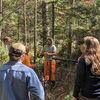The skiing solution | The Maine Winter Sports Center faces the first test of its economic development plan for northern Maine
The sport is biathlon, a combination of Nordic skiing and shooting that is one of the most popular winter sports in Europe; the event is the 2004 Biathlon World Cup. The facility, built in 2000 by the Maine Winter Sports Center, a nonprofit funded largely by the Portland-based Libra Foundation, is world-class. The 400-plus volunteers are ready, and the area's businesses are gearing up for four days of crowds like they've seldom, if ever, seen.
The event is the first big test of MWSC's plan for economic development in northern Maine, which aims to restore skiing as a lifestyle, and, in so doing, help create and build a tourism-based economy in the region. To achieve those goals, MWSC plans to spend money improving Nordic and alpine facilities (by the end of the fiscal year in April, it will have spent a total of $13 million at all its facilities); subsidize their day-to-day operations (skiing is free at the two Nordic centers, and cheap at the alpine hills); get the locals to embrace a healthy, outdoor lifestyle; attract tourism dollars; and make northern Maine a place where people want to both live and play.
However, MWSC officials say, they can't put this bold plan into place on their own. For the long-term goals to be achieved, the private sector needs not only to believe in the plan, but to step up with money of its own. "We brought skiing back to life," says MWSC chairman Brian Hamel, who recently stepped down as president and CEO of the Loring Development Authority to focus on running for Maine's Second Congressional District seat. "We've built the stuff and the programs. Now it's up to the community and the businesses to build up the amenities and make it sustainable down the road."
The communities have already started to do their part, as evidenced by the volunteer turnout in Fort Kent and the construction, spurred by MWSC but undertaken by local residents, of ski trails all over Aroostook County. Businesses seem supportive, and a few new projects are already underway (see "Banking on biathlon," p. 19). Though the effort has brought few tourists to the area so far, it has inspired plenty of hope.
"The Maine Winter Sports Center has created opportunities that just didn't exist," says Scott Arndt, whose family owns a campground and cabins that borders on the Nordic Heritage Center, MWSC's facility in Presque Isle. "Nobody's put a ski shop in Presque Isle yet, and somebody's missing the boat there. There should be a B&B in town, and there isn't. Those types of things probably will happen. I can't say I'm sure of it, or that I know that a bunch of projects are about to take off. But I do think it will happen."
Luring the Europeans
When MWSC built the two Nordic centers (MWSC also operates cross country skiing facilities at Pineland Farms in New Gloucester), the goals were lofty but simple: The facilities would be world-class, in order to draw national and international events, and they'd be accessible to locals, with no- or low-cost skiing. The trails were designed by former Olympic and world-class athletes, and both centers have the state-of-the-art systems across the board, for grooming, timing, drug testing, media access and TV broadcasting. And the events are already on the calendar, with the International Biathlon Union's 2006 World Junior Championships scheduled for the Presque Isle center.
"We've got everything they need, including a group of volunteers we think is second to none," says Andy Shepard, MWSC's president and CEO. "We've got a whole community of friendly people willing to do their part. And we think once [biathlon officials] come, they'll come back."
For the world cup this month, MWSC is estimating economic impact at $1.3 million in direct spending, with multipliers of local re-spending putting the total at $5.2 million. The event will be live, prime-time programming in Europe, with 20 million viewers anticipated abroad, plus another six million viewers of the U.S.-based Outdoor Life Network. MWSC has had events on OLN for two years now. MWSC develops the programming and sponsorships, and then sells the package ˆ Shepard won't say for how much ˆ to the network. The deal, he says, is more about getting exposure to a biathlon friendly audience than it is about bringing in revenue.
To potentially lure Europeans ˆ racers and tourists ˆ the event will have to be a success. Among the MWSC's concerns have been making sure there's enough housing for athletes (130-140 of whom will be the first residents of UMaine-Fort Kent's new, $7 million dormitory), team personnel and media.
MWSC has also been working to ensure that the spectators show up. In Lake Placid, N.Y., biathlon historically has drawn small crowds. Shepard, on the other hand, hopes to create an "Olympic atmosphere" in Fort Kent, to draw future events. Local Mainers and Canadians are expected to make up the vast majority of spectators, with others coming from as far as southern Maine.
"The hope is that we'll have, starting in 2007, a couple of world cups every other year in Aroostook County," Shepard says. "If we can do that, we're talking about close to $11 million in economic impact every other year."
Build it, and they will come
In addition to the economic impact, MWSC officials are serious about affecting the health of Aroostook County residents, who struggle with issues that affect rural, economically depressed areas, such as childhood obesity, smoking and type 2 diabetes. Eventually, Shepard and others believe, economic opportunity will follow. "Create a better quality of life, and all sorts of other things become possible," Shepard says. "At that point you have a large and highly energized group of volunteers. You have a healthy, energized workforce. You have young people who want to stay. All those things are critical to the economic development aspect of this model."
The sense of enthusiasm created by MWSC's plans is nearly tangible in Aroostook County. Caribou High School, for example, boasts a series of cross-country ski trails with snowmaking, lights and a lodge ˆ all the work of volunteers, part of a movement fostered by the centers to build trails all over the county. Carl Soderberg, whose Caribou-based earth-moving firm, Soderberg Construction, worked on the MWSC facilities, spearheaded the trail construction effort in Caribou and has built trails in other towns as well. "There are no skeptics here," Soderberg says. "Or not many, at least. The businesses and the communities are supporting this in every way they can."
Now, on the eve of the first major event, the area's small, tourist-related businesses are hopeful, and waiting. As of the third week in February, Kate and Kevin McCartney, who own the four-room Old Iron Inn in downtown Caribou ˆ about 45 minutes south of Fort Kent ˆ didn't have any reservations from world cup spectators. The McCartneys' clientele is mostly businesspeople; they don't get many snowmobilers, who prefer to stay in motels and group lodgings.
"It's a new thing. It's developing," says Kate McCartney. "We're in the process of, if you build they will come. It's been built, now we're just waiting for them to come. I think it will happen, and I predict great things, and I am very much in favor of not having all of our winter tourism efforts focused only on snowmobiling."
Beyond winter, McCartney points to the area's gorgeous countryside, its low level of traffic, and its rolling hills ˆ and backcountry trails ˆ as a perfect place for bicycling. She hopes for cultural tourism in the area's Swedish colonies and its French Acadian culture.
"It hasn't been Disneyfied," she says of the region. "The tourists who do come here, they find it to be such a relief. We've got something different, something beautiful. I think people will really like it, if we get them up here."
Going downhill
When MWSC started in 1999, its business plan was limited to Nordic skiing. That changed when officials saw how the owners of Big Rock Ski Area struggled to keep up with the capital improvements necessary to maintain their base. So MWSC added alpine skiing to its vision, and bought the Mars Hill facility in the spring of 2000. Since then, MWSC has purchased and improved Quoggy Joe in Presque Isle and Black Mountain in Rumford.
In 1999-2000, Big Rock had just 7,000 skier visits. Last year, the number was 22,000, an increase of 36% over 2001-2002 and a more-than-50% improvement over the season before that.
This winter, cold temperatures and a lack of snow have hampered things, but Tim Prather, Big Rock's general manager, is predicting 15,000 skier visits in a tough year. "We're seeing new people, new families, and our regional market is growing," Prather says. "Even this year, we're still seeing more people from Bangor, more people from Canada, and even people from southern Maine."
MWSC's downhill approach is similar to its Nordic model. The organization pays for approved capital projects and operating expenses (about 94% right now at all three mountains) until the skiers start coming in sufficient numbers to offset all or most of the costs. If that doesn't pan out, though, Shepard says MWSC is committed to footing the bill for operating costs for the long term.
MWSC is investing a little more than $1 million in Big Rock this summer, adding new lifts and trails and converting the old maintenance facility into a children's center, among other improvements. Those changes represent phase two of a five- to eight-year plan to build the ski area into a destination resort, with an ultimate goal of 50,000 skier visits.
But to get the money for any and all of the projects in Big Rock's master plan, the area will have to convince the MWSC, and the Libra Foundation, that it's worth it, considering the goal of having Big Rock ˆ as well as Black Mountain and Quoggy Joe ˆ achieve a level of self-sustainability. All three were struggling to make capital improvements when MWSC stepped in, and now each has to compete with the other facilities for money. That competition may get tougher as the years go by.
For now, Shepard says, MWSC needs to "take a step back, focus on the facilities we have and our operating model, and make sure that the programs are successful. It's not about growth, it's about quality and impact."
Black Mountain, purchased in the spring of 2003 by MWSC, also successfully made its case for capital improvements this year. MWSC, which added an intermediate chair at the Rumford area last fall, has approved funding for the construction of a chair to the summit this summer, which will increase the area from 470 vertical feet to 1,120, and move Black from 12th to seventh in vertical feet among Maine ski mountains. A new lodge and a wax building for Nordic skiers are also slated for this summer, along with paving the parking lots.
Like its Nordic business model, MWSC's alpine model is a long-term one. And for all his emphasis on the areas' ability to eventually support themselves, Shepard refers to self-sustainability as a "by-product."
"There are no models for us to benchmark here," he adds. "No one else is doing what we're doing, so we have to figure it out as we go. The easy part is building a new building; the hard part is figuring out how to do it without burdening the communities, yet still meeting the needs of the community now and in the future. We want to leverage all that for economic impact."










Comments